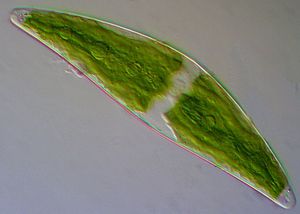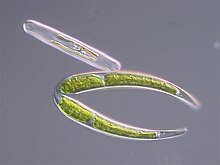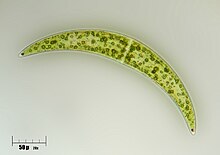Closterium
| Closterium | ||||||||||||
|---|---|---|---|---|---|---|---|---|---|---|---|---|

Closterium moniliferum (209x48µm) |
||||||||||||
| Systematics | ||||||||||||
|
||||||||||||
| Scientific name | ||||||||||||
| Closterium | ||||||||||||
| Nitzsch ex Ralfs |
Closterium is a genus of algae from the group of ornamental algae (Desmidiales), which includes around 300 species.
features
Closterium are unicellular and uncultivated algae. The cells are usually curved, rarely straight. They are not flattened and therefore have a round cross-section and they have no central constriction (sinus). They have two chloroplasts that are star-shaped in cross-section; longitudinal ridges and the centrally arranged pyrenoids are visible in the side view . The nucleus sits in the center of the cell. The vacuoles are located at the two ends of the cell and contain crystals that perform trembling movements due to Brownian molecular motion. At the cell ends, the algae can excrete mucus through pores, which helps the cells to crawl. The cell walls have ornaments: stripes, dots, but never spines or warts. In some species there are cylindrical segments, the girdles, in the middle of the cell.
Asexual reproduction occurs in the manner typical of ornamental algae . Sexual reproduction occurs through conjugation . One to two gametes are formed per cell . The zygotes have a smooth, more rarely a warty surface. They are spherical, rectangular or elliptical, the old cell walls are often still attached to the zygote. The zygote germinates with reduction division .
Depending on the type, the cells are between 25 and 900 micrometers long and 5 to 100 micrometers in diameter. The species differ in their cell shape, the presence or absence of belt ligaments, the number of gametes, the shape and surface of the zygote, and the arrangement or number of pyrenoids.
distribution
The genus is widespread worldwide ( cosmopolitan ). The species live benthically or in plankton , mostly in stagnant, oligotrophic to eutrophic waters. They are often found in moors .
Representative
Common species in Central Europe are:
- Saber alga ( Closterium acerosum )
- Great moon alga ( Closterium ehrenbergii )
- Arc spindle alga ( Closterium kuetzingii )
- Little moon alga ( Closterium leibleinii )
- Sea spindle alga ( Closterium limneticum )
- "Moons" ( Closterium lunula )
- Crescent moon ( Closterium moniliferum )
- Spindle algae ( Closterium pronum )
- Striped spindle alga ( Closterium striolatum )
supporting documents
- Karl-Heinz Linne von Berg, Michael Melkonian u. a .: The Kosmos algae guide. The most important freshwater algae under the microscope. Kosmos, Stuttgart 2004, ISBN 3-440-09719-6 , p. 116.
Individual evidence
- ↑ algaebase , accessed on August 20, 2008.
- ↑ Heinz Streble , Dieter Krauter : Life in the water drop. Microflora and microfauna of freshwater. An identification book. 10th edition. Kosmos, Stuttgart 2006, ISBN 3-440-10807-4 , pp. 200, 212.


